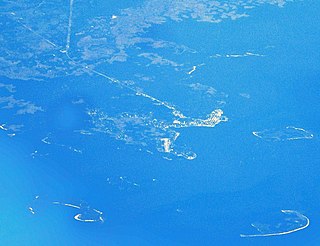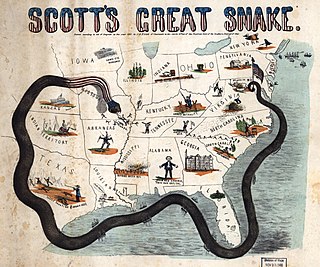
Cedar Key is a city in Levy County, Florida, United States. The population was 702 at the 2010 census. The Cedar Keys are a cluster of islands near the mainland. Most of the developed area of the city has been on Way Key since the end of the 19th century. The Cedar Keys are named for the eastern red cedar Juniperus virginiana, once abundant in the area.

Yerba Buena Island sits in the San Francisco Bay between San Francisco and Oakland, California. The Yerba Buena Tunnel runs through its center and connects the western and eastern spans of the San Francisco–Oakland Bay Bridge. It has had several other names over the decades: Sea Bird Island, Wood Island, and Goat Island. The island may have been named after the pueblo of Yerba Buena, which was named for the plant of the same name that was abundant in the area. The plant's English and Spanish common name, Yerba buena, is an alternate form of the Spanish hierba buena, generally used to describe local species of the mint family.

The Fort Zachary Taylor Historic State Park, better known simply as Fort Taylor, is a Florida State Park and National Historic Landmark centered on a Civil War-era fort located near the southern tip of Key West, Florida.

The Union blockade in the American Civil War was a naval strategy by the United States to prevent the Confederacy from trading.

The Cape Florida Light is a lighthouse on Cape Florida at the south end of Key Biscayne in Miami-Dade County, Florida. Constructed in 1825, it guided mariners off the Florida Reef, which starts near Key Biscayne and extends southward a few miles offshore of the Florida Keys. It was operated by staff, with interruptions, until 1878, when it was replaced by the Fowey Rocks lighthouse. The lighthouse was put back into use in 1978 by the U.S. Coast Guard to mark the Florida Channel, the deepest natural channel into Biscayne Bay. They decommissioned it in 1990.

The Jupiter Inlet Light is located in Jupiter, Florida, on the north side of the Jupiter Inlet. The site for the lighthouse was chosen in 1853. It is located between Cape Canaveral Light and Hillsboro Inlet Light. The lighthouse was designed by then Lieutenant George G. Meade of the Bureau of Topographical Engineers. Meade's design was subsequently modified by Lieutenant William Raynolds. The Jupiter Inlet silted shut in 1854, forcing all building supplies to be shipped in light boats down the Indian River. Work was interrupted from 1856 to 1858 by the Third Seminole War. The lighthouse was completed under the supervision of Captain Edward A. Yorke in 1860 at a cost of more than $60,000.

Fowey Rocks Light is located seven miles southeast of Cape Florida on Key Biscayne. The lighthouse was completed in 1878, replacing the Cape Florida Light. It was automated on May 7, 1975, and as of 2021 is still in operation. The structure is cast iron, with a screw-pile foundation, a platform and a skeletal tower. The light is 110 feet above the water. The tower framework is painted brown, while the dwelling and enclosed circular stair to the lantern is painted white. The original lens was a first-order drum Fresnel lens which stood about 12 feet (4 m) high and weighed about a ton (tonne). The light has a nominal range of 15 miles in the white sectors, and 10 miles in the red sectors.

The Cedar Key Light is located on Seahorse Key across the harbor from Cedar Key, Florida. Seahorse Key was the site a watchtower erected in 1801 by followers of William Augustus Bowles, self-designated Director General of the State of Muskogee, an attempt to set up an independent state in the western part of East Florida. The watchtower was destroyed by a Spanish naval force in 1802. Seahorse Key was used as a detention center for Seminoles captured in the Second Seminole War (1835–1842) before transfer to the West. At that time the Federal government reserved several of the islands in the Cedar Keys archipelago for military use.

The maritime history of Florida describes significant past events relating to the U.S. state of Florida in areas concerning shipping, shipwrecks, and military installations and lighthouses constructed to protect or aid navigation and development of the Florida peninsula.

Sand Key Light is a lighthouse 6 nautical miles southwest of Key West, Florida, between Sand Key Channel and Rock Key Channel, two of the channels into Key West, on a reef intermittently covered by sand. At times the key has been substantial enough to have trees, and in 1900 nine to twelve thousand terns nested on the island. At other times the island has been washed away completely.

Egmont Key State Park and National Wildlife Refuge is a Florida State Park located on the island of Egmont Key, at the mouth of Tampa Bay. Egmont Key lies southwest of Fort De Soto Park and can only be reached by boat or ferry. Located within Egmont Key State Park are the 1858 Egmont Key Lighthouse, maintained by the U.S. Coast Guard, and the ruins of Fort Dade, a Spanish–American War era fort that housed 300 residents. Egmont Key is located in Hillsborough County Florida on a narrow strip of the county that extends along the Tampa Port Shipping Channel.

The St. Johns River Light is a decommissioned lighthouse in Jacksonville, Florida, U.S., which stands near the mouth of the St. Johns River. It is located on the grounds of Naval Station Mayport in the Mayport area. Constructed in 1858, it was decommissioned in 1929 and replaced with a lightship. It is sometimes known as the "Old St. Johns River Light" to distinguish it from the modern St. Johns Light, built in 1954.

The current Egmont Key Light dates from 1858. It is the oldest structure in the Tampa Bay area still used for its original purpose.

The Gasparilla Island Lights are on Gasparilla Island in Boca Grande, Florida. The Port Boca Grande Lighthouse is on the southern tip of Gasparilla Island, and marked the Boca Grande Pass entrance to Charlotte Harbor.

The St. Johns Light is an active lighthouse in Jacksonville, Florida, marking the mouth of the St. Johns River. Built in 1954, it is located on Naval Station Mayport in the Mayport area. It was erected to replace a lightship, which itself replaced the still-standing Old St. Johns River Light. It is the fourth lighthouse built at the mouth of the St. Johns since 1830. It was listed on the National Register of Historic Places in 2018.

The Harry S. Truman Little White House in Key West, Florida was the winter White House for President Harry S Truman for 175 days during 11 visits. The house is located in the Truman Annex neighborhood of Old Town, Key West.

The second USS Suwannee and third USS Mayflower was a United States Lighthouse Board, and later United States Lighthouse Service, lighthouse tender transferred to the United States Navy in 1898 for service as an auxiliary cruiser during the Spanish–American War and from 1917 to 1919 for service as a patrol vessel during World War I. She also served the Lighthouse Board and in the Lighthouse Service as USLHT Mayflower from 1897 to 1898, from 1898 to 1917, and from 1919 to 1939, and in the United States Coast Guard as the first USCGC Mayflower (WAGL-236) in 1939 and from 1940 to 1943 and as USCGC Hydrangea (WAGL-236) from 1943 to 1945.

Fort Jefferson is a massive but unfinished coastal fortress. It is the largest brick masonry structure in the Americas, and is composed of over 16 million bricks. The building covers 16 acres (6.5 ha). Among United States forts, only Fort Monroe in Virginia and Fort Adams in Rhode Island are larger. The fort is located on Garden Key in the lower Florida Keys within the Dry Tortugas National Park, 68 miles (109 km) west of the island of Key West. The Dry Tortugas are part of Monroe County, Florida, United States.

St. George Coast Guard Station, or the Staten Island Coast Guard Station, located adjacent to the Staten Island Ferry St. George Terminal, is a complex of 22 historic buildings and was best known for the invention and manufacturing of lighthouse equipment. The Office Building and U.S. Light-House Depot Complex, designed by Alfred B. Mullet and completed in 1865, are listed on the National Register of Historic Places, and comprise an official New York City Landmark.

The Ninth District Lighthouse Depot is a collection of historic structures located at 1 Lighthouse Lane in St. Joseph, Michigan. It was listed on the National Register of Historic Places in 1993. It now houses the Saint Joseph River Yacht Club.
























